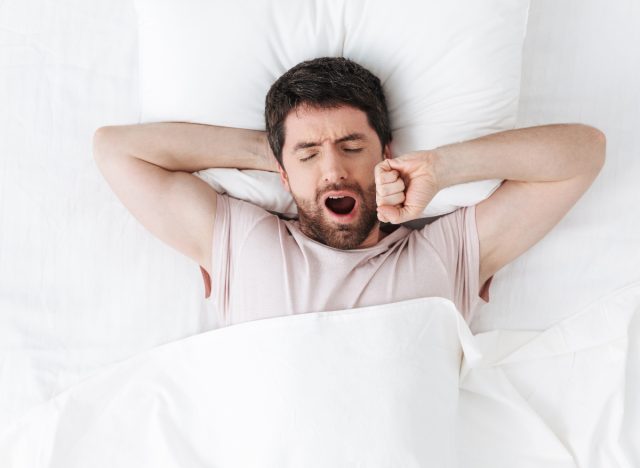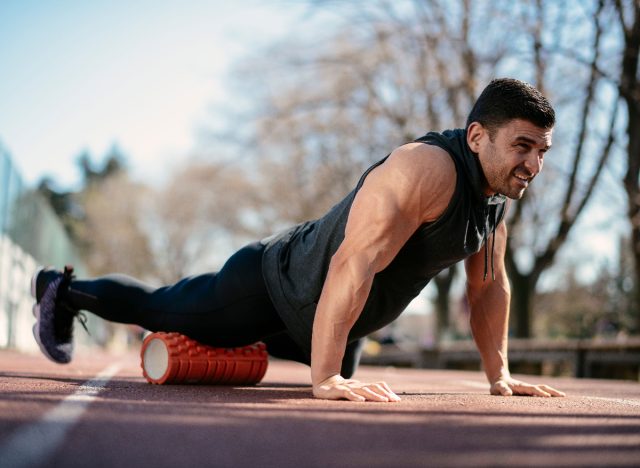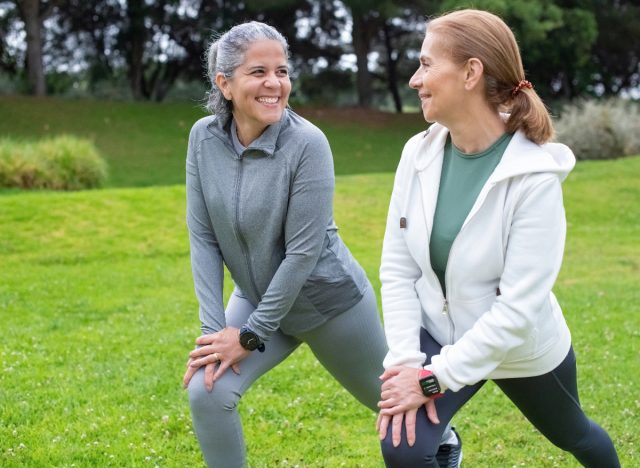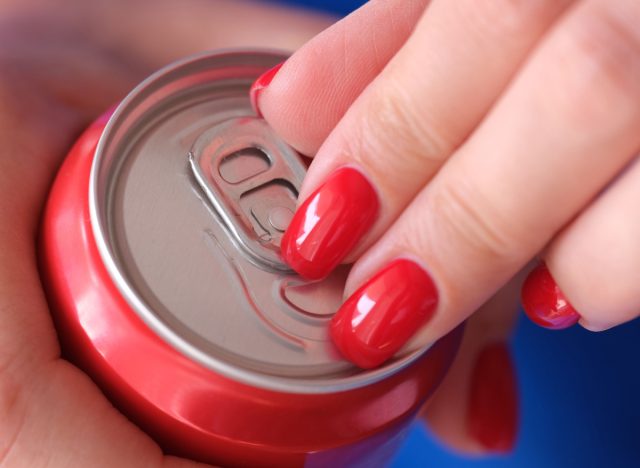When you’re striving to achieve a fitness goal, it’s vital to ensure that every aspect of your routine is optimized for success. This encompasses not only the actual workout but also the habits you maintain before and after exercising. We consulted with certified personal trainers who pinpoint 10 common post-workout blunders that can undermine your progress. By being aware of these errors, you can adjust your approach as needed and steer clear of them.
Continue reading to discover the advice from the experts regarding the 10 most detrimental post-workout mistakes that can hinder your fitness gains. After you’re done, make sure to check out the 6 Best Pilates Exercises for Enhancing Your Balance & Coordination.
Drinking caffeine after working out

One of the biggest blunders you can commit after completing a workout is reaching for a drink that is high in caffeine content. Therefore, it’s best to steer clear of energy drinks or cups of coffee!
“Physical exercise is a stressor on the body, and when the body senses stress, cortisol is released,” explains Alissa Tucker, NASM-CPT and master trainer for AKT. “Caffeine also increases cortisol levels in the body. Cortisol is a naturally occurring hormone in the body, and while we do need it, chronic high levels of cortisol can result in many health issues including inflammation and weight gain.”
Tucker suggests enjoying your morning coffee before working out and choosing a hydrating beverage such as coconut water or water after your workout.
“Research has shown that caffeine pre-workout can improve performance, amp up motivation, and reduce muscle soreness during your workouts,” Tucker points out. “Meditation post-workout or simply setting a timer on your phone for three to five minutes and focusing on deep breathing can help you switch from your sympathetic to your parasympathetic nervous system and help to bring down your cortisol levels more quickly.”
Not getting enough sleep

Your body experiences its recovery phase when you sleep, which is why sufficient rest after working out is crucial. “During deep sleep (non-REM sleep), your breathing slows and your blood pressure drops,” explains Tucker. “Your brain is also resting so there is more blood flow carrying oxygen and nutrients to your muscles helping them to recover, heal, and grow. It is also during this deep sleep [when] your body releases human growth hormone which stimulates tissue growth and muscle repair.”
The Sleep Foundation recommends healthy adults aim for at least seven hours of sleep each night. “While a 6 a.m. workout may seem like the healthiest way to start your day, those early mornings might actually be sabotaging your health goals if it means that you’re not sleeping enough,” explains Tucker. “Prioritize your sleep. Practice good sleep hygiene by limiting screen time before bed or using blue light-blocking glasses, avoid alcohol and other stimulants, and avoid eating too close to bedtime.”
Foam rolling too quickly (or not doing it at all)

The first step is making sure you foam roll after workouts; the second is doing it properly. “These days, most active people have heard of the benefits of foam rolling or self-myofascial release (SMR). While that is amazing, I still see the majority of people doing it incorrectly,” Tucker tells us. “The goal of foam rolling is to alleviate adhesions or trigger points (knots) in the fascia. While it may feel like a nice massage to just roll back and forth over a sore muscle, moving quickly doesn’t actually initiate the golgi tendon organ to stimulate, which doesn’t have any real beneficial effect on the body.”
Determine the areas of your body where you’re experiencing tightness or pain. Make sure to foam roll slowly, and hold the foam roller at each trigger point for 30 to 45 seconds to alleviate tension. “When held for long enough on the trigger point, the golgi tendon organ will essentially turn off the muscle spindle activity, allowing your muscle fibers to stretch, unknot, and realign,” says Tucker.
Rushing into another intense workout

Tucker says this one may sound silly, but she’s experienced plenty of “workout-obsessed clients” who perform “doubles,” aka, high-intensity workouts back-to-back. “While occasionally this may be okay with certain types of exercise, too much high-intensity exercise without proper recovery time can cause chronic high cortisol levels, deplete glycogen stores, disrupt metabolism, and increase the risk of injury if done regularly—all of which can negatively impact workout results,” she explains.
As previously stressed, rest and recovery time is a critical part of the process. Tucker recommends taking eight hours—but ideally 24 hours—for your body to sufficiently recover between intense workouts. If you feel the need to squeeze in an extra workout, opt for a lower-intensity strength workout paired with a higher-intensity cardio routine. “Or, skip the second workout altogether and opt for gentle activity like walking in nature or a leisurely bike ride—both of which can help to balance cortisol levels,” Tucker suggests.
Putting yourself in a stressful situation

We’ve established that the stress hormone cortisol is released when you work out. If you’re constantly stressed, your cortisol levels remain high, which can result in a variety of health issues and substantially hold you back from achieving your fitness goals by making you gain belly fat, crave unhealthy foods, and mess up your metabolism.
“Take a tip from the yogis and add a savasana, or some sort of mindful practice to the end of your workout to allow your nervous system to regulate before heading back to work, traffic, etc.,” Tucker recommends. “This could look like laying down for five minutes, gentle breathwork, a guided meditation, or even a leisurely walk outside. Building this time into the end of your workout can help you switch from the sympathetic (fight or flight) to parasympathetic (rest and digest) and improve exercise results in the long run.”
Not consuming enough protein

If you’re not consuming enough protein after workouts, you could feel fatigued and weak and not recover productively. “If you neglect this macro too much, you could also lose muscle mass,” explains Sasha Mihovilovic, NASM-CPT and master trainer for AKT.
To avoid this pitfall, enjoy some protein within 30 to 90 minutes after working out. For a quick protein-packed treat, adding your favorite protein powder to a shaker bottle with water, coconut water, or dairy-free milk is seamless to put together. “[In addition,] if you have time, you could make a smoothie or have one prepared before your workout,” Mihovilovic adds. “This will maximize post-exercise muscle protein synthesis rates and help with more efficient and effective muscle recovery. Just like I would pick out my workout outfit the night before, I always have a post-workout protein source prepared as well.”
Drinking alcohol

Drinking alcohol after exercising is another mistake you shouldn’t risk making. Mihovilovic explains it can result in heart disease, high blood pressure, stroke, digestive issues, and liver disease. In addition, dehydration is a side effect that comes on immediately.
“It’s important to replace the fluids lost from sweating before consuming alcohol, which would cause further dehydration. It can also prevent muscles from healing efficiently following your workout,” Mihovilovic tells us. If you’re celebrating something special or heading out with friends post-workout, opt for sparkling water, kombucha, freshly squeezed green juice, or a hydrating mocktail instead.
Not cooling down or stretching

“The reason for a cool down is to return your heart rate back or close to your resting heart rate,” says Mihovilovic. “Stopping immediately without a cool-down can cause lightheadedness, dizziness, or fainting. Static stretching and foam rolling (being a part of your cool down) are also important because they can help improve range of motion in the joints, decrease the risk of injury, relieve potential cramping, assist with circulation, and decrease muscle soreness.”
Make it your goal to carve out three to five minutes for cooling down after your workouts. Work out with the mindset that your cool-down is just as crucial as your main workout itself. “What I see often is clients that think if it’s not actively burning calories or feeling incredibly intense, it’s not beneficial,” Mihovilovic points out. “If you are planning to do a 30-minute workout, make sure that the last three to five minutes of that 30-minute incorporate your cool-down.”
Eating sugary, overly processed foods and beverages

Choosing foods and drinks with a high glycemic index can cause quick changes in blood sugar levels. If this occurs regularly, it can result in diabetes, heart disease, and obesity, Mihovilovic notes.
“After your workout, if you suddenly crave sugar and sweets, this is your body’s way of signaling that your glycogen stores need to be replenished and is your reminder to refuel,” explains Mihovilovic. “Instead of reaching for simple carbohydrates or sugary drinks like soda, go for whole fruits, vegetables, and complex carbohydrates! After an ultra sweaty and intense workout my go-to is coconut water, watermelon water, a banana, or fresh berries!”
Having a “this for that” mentality

Having a consistent “this for that” mentality—for instance, going on a five-mile run and using that to justify eating pizza afterward—is a major no-no.
“The mindset of exchanging working out/burning calories for allowing yourself to eat or the reverse (eating poorly then exercising as a ‘punishment’), is a slippery slope,” says Mihovilovic. “If you are consistently bartering exercising in exchange for food, long-term this can condition an unhealthy relationship and mindset around food, which leads to binge eating, anxiety around eating and exercise, unnecessary feelings of guilt, and overall an unbalanced diet.”
Think of your food as fuel, or “energy drawn in,” and working out as “energy processed out.” Both depend on the other to operate successfully. Food provides nourishment to your body; it keeps your brain active, your muscles working properly, and your heart beating, explains Mihovilovic. Savoring a meal with loved ones gives you a sense of community and enjoyment. In addition, regular exercise is something your body wants and needs. “Aiming to think of eating and exercising as necessary components of being alive and having fun can start to disrupt the ‘this for that’ mentality!”
Frequently Asked Questions (FAQs) About the 10 Worst Post-Workout Mistakes That Ruin Your Gains
Q: Why is it important to avoid these post-workout mistakes?
A: Avoiding these mistakes is crucial because they can hinder your muscle recovery, growth, and overall fitness progress. Making the right choices after a workout is essential to maximize the benefits of your exercise routine.
Q: What are some common post-workout mistakes that people make?
Skipping the Cool Down:
Neglecting to cool down after a workout can lead to muscle soreness and stiffness.
Not Hydrating Adequately:
Dehydration can impair muscle recovery and performance.
Skipping Post-Workout Nutrition:
Not refueling your body with the right nutrients can slow down muscle repair and growth.
Ignoring Stretching:
Forgetting to stretch can lead to muscle tightness and potential injuries.
Overtraining:
Exercising too much without proper rest can hinder muscle recovery and growth.
Not Getting Enough Sleep:
Inadequate sleep can negatively impact muscle recovery and growth.
Q: How can I avoid these post-workout mistakes?
A: To avoid these mistakes, make sure to incorporate a proper cool down, hydrate adequately, consume a post-workout meal rich in protein and carbohydrates, include stretching in your routine, allow for rest days to prevent overtraining, and prioritize getting enough quality sleep.
Q: What are the consequences of making these post-workout mistakes?
A: The consequences of these mistakes can range from delayed muscle recovery and increased risk of injuries to hindered muscle growth, decreased performance, and overall slower progress in your fitness journey.






